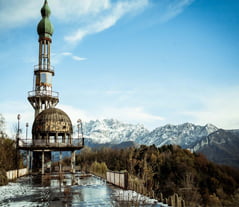 For most of its history, Consonno, located in the hills of Brianza, in the Lombardy region, was an agricultural town with a population that never surpassed 300 inhabitants. The town has its origins in the Middle Ages, but thanks to its remote location and only one road leading to the town’s entrance, Consonno never truly thrived. Despite this, an eccentric magnate named Count Mario Bagno saw a unique opportunity in this meek village.
For most of its history, Consonno, located in the hills of Brianza, in the Lombardy region, was an agricultural town with a population that never surpassed 300 inhabitants. The town has its origins in the Middle Ages, but thanks to its remote location and only one road leading to the town’s entrance, Consonno never truly thrived. Despite this, an eccentric magnate named Count Mario Bagno saw a unique opportunity in this meek village.
In 1962, Count Bagno purchased Consonno for 22,500,000 lire, evicted its few residents, and completely demolished the town leaving only the Church of San Maurizio, the rectory, and the cemetery standing. Bagno’s vision was to transform Consonno into a resort-town resembling an adult playground attracting tourists from nearby Milan with shopping galleries, bars, casinos, and extravagant hotels.
Once construction began, workers were ordered to not only completely destroy the previous town, but also the natural landscape of the surrounding area. Hills near Consonno were moved and removed and areas with hard rock were flattened with explosives in order to create better panoramic views from the town. A variety of mismatched architecture styles were used to construct the pleasure city’s new buildings including a minaret resembling a mosque, a medieval castle, and a Chinese pagoda. Bagno’s meddling with the natural landscape and not cohesive architecture drew the ire of the citizens of nearby towns such as Lecco and Olginate. Construction was delayed numerous times because of Bagno’s indecision regarding the design of the town; he would change his mind frequently in the middle of construction projects. Consonno’s opening to the public was delayed, but when it finally opened it experienced a momentary tourism boom from the late 1960s to the early 1970s.
Unfortunately for Bagno, his decision to destroy the natural landscape surrounding the town cost him dearly. In October 1976, a landslide most likely caused by the excessive modification of the land in the area, destroyed the only road that lead to Consonno. This meant that neither visitors nor supplies could enter the town and this led to its abandonment.
Today the town is still officially abandoned and access is mostly restricted, though the road that was destroyed by the landslide in 1976 was rebuilt in 2010. There have been talks of completely demolishing the town, but no concrete plans have materialized. Recently, some of the ex-townspeople and their descendants have formed a group called Amici di Consonno (Friends of Consonno) in order to revive interest in the town. They founded a bar in town called Bar de La Spinada which is open during weekends starting the day of Pasquetta (the Monday after Easter) until October. They also organize events throughout the year including Pasquetta a Consonno (an Easter celebration), La Sagra di San Maurizio (in honor of the patron saint of Consonno), and La Burollata (a chestnut festival). In this way, the Amici di Consonno are attempting to change the perception of Consonno and turn it into a place where people who live in nearby towns, such as Olginate, can spend time together. The group also hopes to use profits from the bar to restore the rectory. With the help of this dedicated community hopefully one day Consonno will return to what it was before Bagno’s intervention: a small, quiet town with humble and committed citizens.